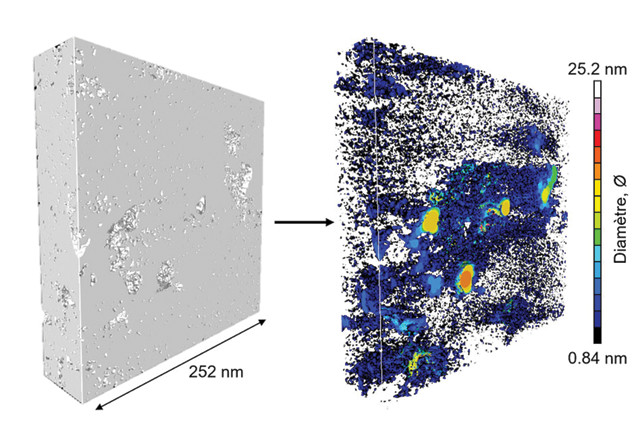
by Mary Caperton Morton Wednesday, February 13, 2019

At left is a digitized image of the exterior of a kerogen sample; at right is a three-dimensional image of its internal pore structure as revealed by electron tomography. Credit: Roland Pellenq/MIT.
The petroleum and natural gas that power engines and heat homes are extracted from the complex networks of nooks and crannies that permeate kerogen — a waxy organic mishmash that forms within sedimentary rocks as algae, terrestrial plants and other organic matter is compacted and heated over geologic time. In a new study, scientists have taken the closest look yet at kerogen’s internal pore structure, and the resulting images are helping scientists understand why some oil and gas reservoirs are more productive than others.
To investigate how oil and gas move through these pores, a team led by Roland Pellenq of MIT used electron tomography to image the internal structure of three types of kerogen down to a resolution of less than 1 nanometer. Previously, the best attempts to image kerogen had achieved a resolution of about 50 nanometers, Pellenq says.
Electron tomography involves rotating a small sample of material within a microscope while a beam of electrons shines through the structure, creating cross sections from many angles that can be combined to produce a three-dimensional image. Images collected in the new study, published in Proceedings of the National Academy of Sciences, show how the internal pore structure of kerogen changes with the material’s age and maturity. “This is the first time we have gotten to see kerogen’s nanopore structures directly,” Pellenq says.
They found that immature kerogen, which has not been as thoroughly cooked and compacted deep in Earth’s crust, tends to have larger pores that are not well connected, making it harder to extract accompanying oil and gas. “This lack of interconnectivity may be the reason why some reservoirs produce very little oil and gas, no matter what kind of stimulation we apply,” Pellenq says.
As kerogen matures over time, though, the pores become smaller but more numerous and more interconnected, the team concluded from their images, creating passages for oil and gas to move through the rock and easing extraction. Geologists can predict maturity using geochemical methods, and mature reservoirs are sought after by the petroleum industry, but the reasons why mature rocks are more efficient producers have been unclear, Pellenq says.
The images also revealed that the pore sizes in both the immature and mature samples were smaller than expected — so small that the fluid dynamics at work within kerogen do not conform to the hydrodynamic equations typically used to calculate how fluids move through porous materials. “At this scale, the [majority of the] fluids are in such close contact with the pore walls that their interactions with the walls are what dominates the fluid’s behavior,” he says.
The study may inspire new ways to model how fluids move through highly porous media, says Manika Prasad, a geophysicist at the Colorado School of Mines who was not involved in the new study. “I would like to see somebody use these images to figure out how much storage capacity these pore structures might have for both kerogen and carbon dioxide,” she says. “That would be a really interesting next step for this line of work.”
Pellenq says he and his colleagues plan to apply the same electron tomography methods to a wider range of kerogen samples to better understand how the geologic and thermal histories of source rocks affects the rate of maturation. And they hope to eventually develop a formula for predicting the internal pore structure of different kerogens — and thus the productivity of the source rocks — based on a given sample’s maturity.
© 2008-2021. All rights reserved. Any copying, redistribution or retransmission of any of the contents of this service without the expressed written permission of the American Geosciences Institute is expressly prohibited. Click here for all copyright requests.